Computer graphics movie of the star formation history in the galaxy MACS1149-JD1. The self-gravitating nature of matter creates filamentary structures and the density at the intersections of the filaments increases. Around 200 million years after the Big Bang, active star formation ignites in the high density regions, which leads to the formation of galaxies. The gas in the galaxy is blown off by active stellar wind and supernovas, then the gas returns to the galaxy and causes another burst of star formation. Credit; ALMA (ESO/NAOJ/NRAO)
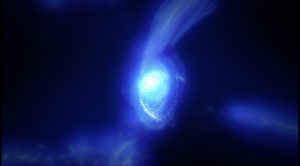
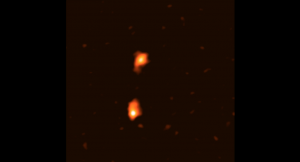
Merging galaxies in the early universe captured with ALMA.
Animation zoom-in of the composite image of ADFS-27 galaxy pair. The initial image is from ESA’s Herschel Space Observatory. The object was then detected by ESO’s Atacama Pathfinder EXperiment (APEX) telescope. ALMA (final zoom) was able to identify two galaxies: ADFS-27N (for North) and ADFS-27S (for South). The starbursting galaxies are about 12.8 billion light-years from Earth and destined to merge into a single, massive galaxy.
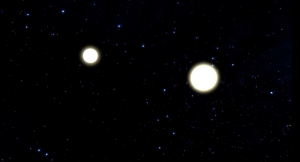
Animation of Neutron Star Merger and Aftermath
Animation of the merger of two neutron stars. As the two bodies draw closer together, they circle each other hundreds of times each second until they eventually collide, producing a tremendous explosion and an expanding shell of debris. This detonation also produces gravitational waves, which travel outward at the speed of light.
The collision also may create a black hole at the center.
Following the explosion, high-power jets of particles traveling nearly the speed of light quickly encounter the expanding debris, forming a cocoon of high velocity material, and then travel into interstellar space where they excite the dust and gas between the stars, producing an enduring radio “glow” that astronomers can study from Earth.
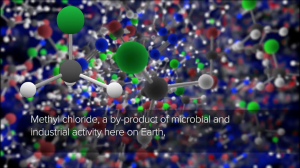
Methyl Chloride Discovered in Two Different Places
Organohalogen methyl chloride discovered by ALMA around the infant stars in IRAS 16293-2422. These same organic compounds were discovered in the thin atmosphere surrounding 67P/C-G by the Rosetta space probe.
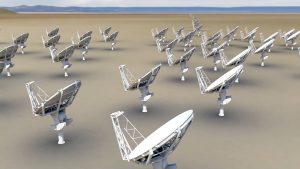
Planning Begins For Next Leap Forward in Research Capability
The National Radio Astronomy Observatory (NRAO) and Associated Universities, Inc. (AUI) are launching a new initiative to design a next-generation radio telescope with scientific capabilities far beyond those provided by any existing or currently proposed observatory. Building on the success of one of the National Science Foundation’s (NSF) flagship observatories, the Karl G. Jansky Very Large Array (VLA), NRAO and AUI are beginning a two-year project to explore the science opportunities, design concepts, and technologies needed to construct a new class of radio telescope. This proposed array, consisting of more than 200 antennas, would extend across the desert southwest of the United States and into northern Mexico. Currently dubbed the next-generation Very Large Array, or ngVLA for short, the new research facility will be designed to provide the next leap forward in our understanding of planets, galaxies, black holes, and fundamental physics.

#WAWUA – ALMA and the Cold Interstellar Clouds
With colorful artwork and clever animations, these short videos delve into topics that explain the fundamentals of radio astronomy, including interferometry (why an array of antennas works as one telescope), astrochemistry (the molecules and elements found in space), the basics of light and the electromagnetic spectrum, the hidden features of the “cold” universe, and the origin and destiny of stardust.
Credit: María Corrêa-Mendes et al. – ALMA (ESO/NAOJ/NRAO)
Episode 05 | Season 01





